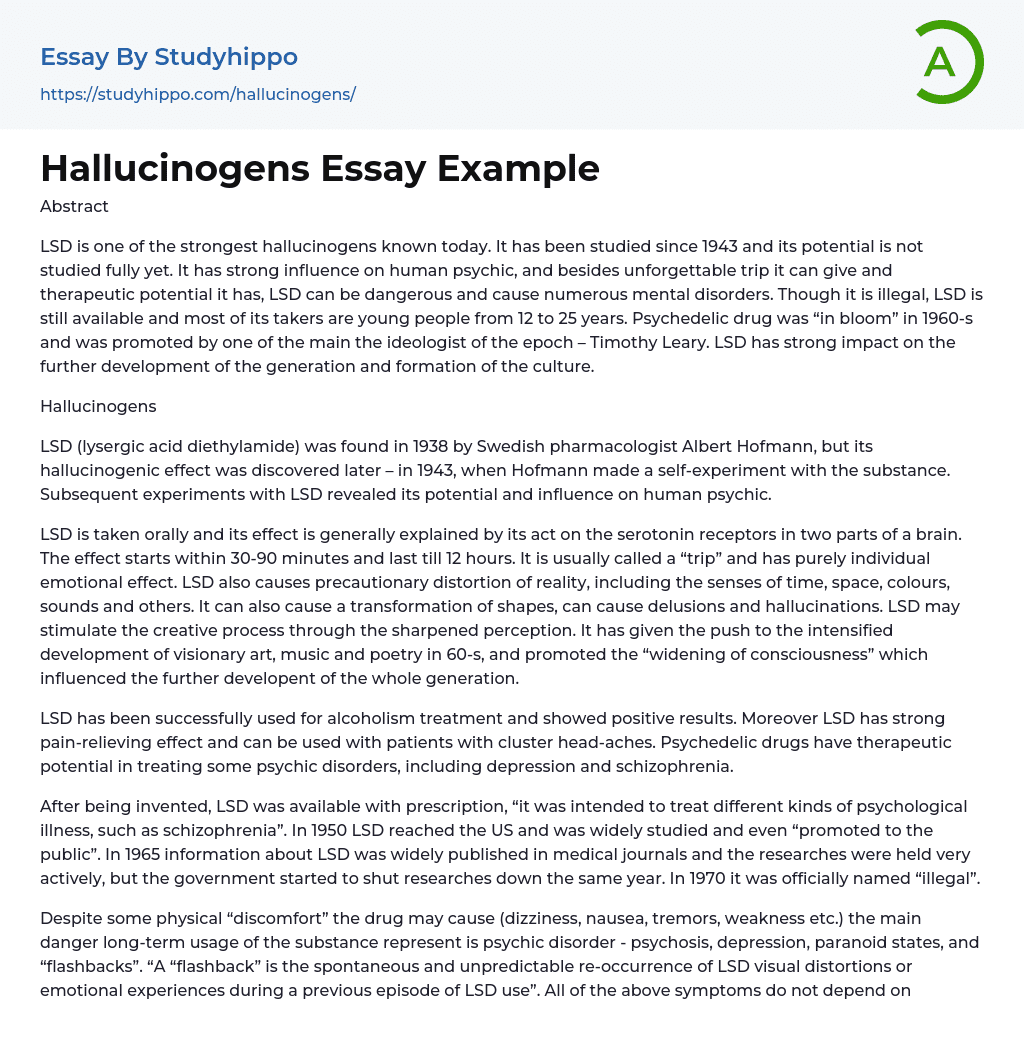The abstract delves into the impact and potential dangers of LSD, a potent hallucinogenic substance. Despite being illegal, LSD remains widely accessible and popular among individuals aged 12 to 25. Its popularity surged in the 1960s when Timothy Leary advocated for its use, greatly influencing the development and culture of that era.
When taken orally, LSD affects serotonin receptors in the brain, resulting in a prolonged "trip" that can last up to 12 hours. This experience distorts reality by altering perceptions of time, space, colors, and sounds while potentially inducing delusions and hallucinations. Furthermore, LSD is associated with heightened creativity due to enhanced perception. It played a significant role in nurturing visionary art, music, and poetry during the 60s while expanding consciousness for an entire generation.
Moreover, it demonstrated promise as a remedy for alcoholism and cluster headaches due to its analgesic properties. Psyc
...hedelic substances like LSD held therapeutic potential in addressing psychological disorders such as depression and schizophrenia. Initially created as a treatment for illnesses like schizophrenia, LSD was prescribed upon its invention.
Extensive research on and promotion of LSD occurred in the United States throughout the 1950s through medical literature until governmental restrictions were imposed in 1965. Finally, it was officially deemed illegal in 1970.The use of LSD can cause physical discomfort, including dizziness, nausea, tremors, and weakness. However, the primary concern lies in potential long-term mental health effects such as psychosis, depression, paranoid states, and flashbacks. Flashbacks involve unexpected recurrences of visual distortions or emotional experiences from previous usage episodes and can occur even after a single instance of use regardless of dosage.
Timothy Leary popularized the hippie slogan "Turn on, Tune in and Drop out,
which symbolized becoming receptive to different levels of consciousness through drugs (turn on), interacting with the external world and expressing internal perspectives (tune in), and embracing self-reliance and change while discovering one's uniqueness (drop out).
Statistics show that individuals aged 18-25 years old and high school students are the primary users of LSD. Although its popularity declined after a resurgence in the 1990s, approximately 9.7 percent of people over the age of 12 have tried LSD at least once. In the United States alone, there are an estimated 23 million people who have experimented with LSD, with around 600,000 new users emerging each year.
An interesting technique among psychedelics enthusiasts is the "smoking toad" method. Certain species of toads produce hallucinogenic substances called bufotoxins in their parotoid glands. These secretions can be dried and smoked similar to marijuana; however heat must be applied to eliminate the chemicals from the substance.Peyote and Mescaline have a long history of use in religious rituals by the Aztecs and Native Americans. These substances were believed to enable communication with Gods and the Great Spirit, who is responsible for creating our universe. The peyote cactus is considered to possess divine power from the Great Spirit, which can be transmitted through its usage.
When consuming hallucinogenic drugs, the "set" (referring to an individual's emotions and general state of mind) and "setting" (referring to the physical location where one consumes these drugs) are crucial factors that greatly influence one's experience. Timothy Leary introduced the term "set," while "setting" relates to how a person reacts to the transformative effects of these drugs based on their environment.
Furthermore, setting plays a vital role in therapy sessions that incorporate
hallucinogenic substances.
- Cocaine essays
- Why Marijuana Should Be Legalized essays
- Drug Abuse essays
- Teenage Drug Abuse essays
- Insanity essays
- John Locke essays
- 9/11 essays
- A Good Teacher essays
- A Healthy Diet essays
- A Modest Proposal essays
- A&P essays
- Academic Achievement essays
- Achievement essays
- Achieving goals essays
- Admission essays
- Advantages And Disadvantages Of Internet essays
- Alcoholic drinks essays
- Ammonia essays
- Analytical essays
- Ancient Olympic Games essays
- APA essays
- Arabian Peninsula essays
- Argument essays
- Argumentative essays
- Art essays
- Atlantic Ocean essays
- Auto-ethnography essays
- Autobiography essays
- Ballad essays
- Batman essays
- Binge Eating essays
- Black Power Movement essays
- Blogger essays
- Body Mass Index essays
- Book I Want a Wife essays
- Boycott essays
- Breastfeeding essays
- Bulimia Nervosa essays
- Business essays
- Business Process essays
- Canterbury essays
- Carbonate essays
- Catalina de Erauso essays
- Cause and Effect essays
- Cesar Chavez essays
- Character Analysis essays
- Chemical Compound essays
- Chemical Element essays
- Chemical Substance essays
- Cherokee essays




